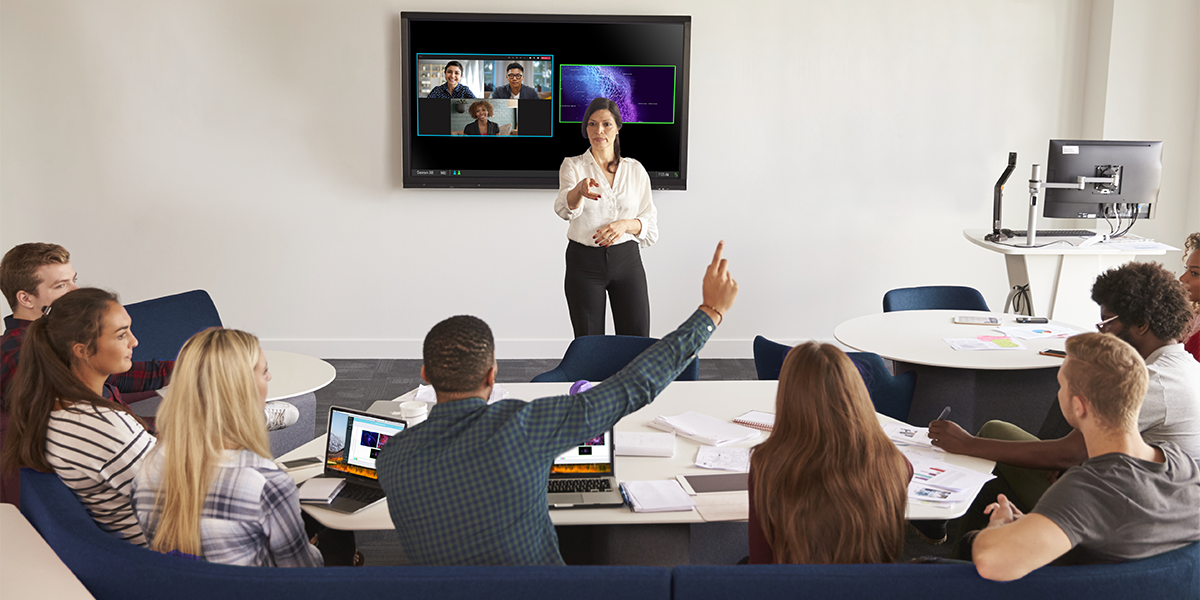The hybrid workplace is here to stay—at least for the forseeable future. At the height of the pandemic, organizations focused on how to bring employee training to a fully remote workforce; now, they face the challenge of providing adequate instruction to team members that may be in the office or working from home. The task of deploying the technology to support hybrid employee training falls to AV designers and integrators, as they work with their clients to re-envision what today’s corporate classroom should look like.
The good news is this exercise isn’t entirely new. Since March 2020, higher education institutions have been forced into the hybrid learning model and are, therefore, a good source for guidance on how to deploy these spaces in the corporate environment. “The enterprise world should borrow lessons learned from the educational space for sure,” said Christopher Jaynes, founder and CTO at Mersive Technologies Inc., a collaboration and presentation software developer headquartered in Denver, CO. “There’s a rich community of users, there’s a rich community of people that are in IT and technology that are thinking very specifically about how students learn.”
“It’s great to be proactive and set some remote or virtual sessions so users can familiarize themselves with the technology before they even come back to the office.”
Sean Edwards, AVI-SPL
One issue organization across the globe are grappling with is how to maintain equity in hybrid meetings. This same concern applies to the corporate classroom. This is concerning to Jaynes because “equity” often means a compromised in-person experience or a sub-par remote experience (or both). He cited examples of on-site employees attending hybrid meetings in the corporate conference room, only to be instructed to participate via their laptops—while sitting next to each other––so their remote colleagues have equal footing. He argued that this is not the way to provide the best experience possible to either group.

This isn’t to say that remote participants should be ignored, Jaynes said. They need to be able to hear what’s going on in the classroom, and multi-camera systems should afford them a clear view of the room and its occupants. It should also be possible to get everyone’s attention when they have a question.
[LG Displays Bring 'Wow Factor' to AVI-SPL's New Dallas Office]
At the same time, the physical learning space should allow for an engaging in-person session. “People went there because they didn’t want the remote experience, they wanted an in-person experience,” Jaynes added. “You’ve got to design for that.”
Expanded Audio and Video Needs
Like Jaynes, Holger Stoltze, director of product management at Yamaha Unified Communications in Sudbury, MA, encourages AV designers and integrators working on corporate classrooms to look to higher education for inspiration. Specifically, he points to how universities have configured their audio systems to accommodate hybrid learning.
Pre-COVID, the design goal behind most corporate classrooms was to deliver a one-to-many experience. The trainer was miked and recorded, and the audience was not. In a hybrid scenario, this is no longer adequate. Remote participants must not only be able to hear the trainer; during more interactive sessions, they must hear their colleagues as well.
[Yamaha Unified Communications Roadmap 2022]
This need for interactivity means miking the entire room with ceiling microphones and/or tabletop mics (depending on the size of the venue). It also requires some form of audio switching or DSP programming that will prioritize the microphones according to who is speaking at any given time, with the highest priority reserved for the trainer. “You need to be able to capture everything that’s being said by anybody in the room,” Stoltze explained.

Video in a hybrid corporate classroom must also be expanded to include everyone in the room, not just the trainer. The larger the space, the more cameras will be required. It is also necessary to determine whether the cameras will be operated manually or if they need to feature automated tracking functionality. Again, the size of the space and the sophistication of the training session will determine this. Some sessions may warrant dedicated camera operators, whereas others may not merit this investment. Regardless, remote participants should have a clear view of everyone, including facial expressions.
[Yamaha UC, Mersive Team on BYOM Room System]
Stoltze also pointed out the need for additional video displays in the corporate classroom. On-site participants should be able to see their remote counterparts, which mandates one or more displays within their line of sight. Plus, the trainer needs to see the remote participants in order to address them or answer questions when they raise their hand or signal, via the conferencing platform, that they’d like to speak. Often, this requires at least a second display or more, depending on how many people are attending virtually.
“You actually need a second set of displays at the far end so the trainer can see the people who are in the room as well as the people who are remote,” Stoltze said. “It’s actually an easy solution, or a comparatively easy solution, but it costs money and doubles some of the investment.” However, he added, to succeed at hybrid learning, the additional investment is necessary for both instructors and participants to be able to enjoy as natural a training session as possible.
Training for Training
At AVI-SPL, a digital enablement solutions provider headquartered in Tampa, FL, Sean Edwards thinks a lot about corporate training. As manager of global training and adoption services at the firm, he works with clients to teach them how to use the technology that they will apply to their own collaboration and training sessions.
With organizations in various stages of return-to-work—and, of course, with many adopting a hybrid work strategy—he said much of the training the firm is offering is in virtual format. Through 30 to 60-minute training sessions, Edwards and his team offer refresher classes and new training so that users are more comfortable with the tech once they’re on site.

“It’s great to be proactive and set some remote or virtual sessions so users can familiarize themselves with the technology before they even come back to the office,” Edwards explained. “In a lot of cases, it’s been 18 months since folks have been in the office. Not only have they gotten away from the technology that may have been there, but in many cases the technology has actually changed.”
AVI-SPL also offers in-person training, and supplements what’s covered in class with flipbooks, quick-start guides, and on-demand videos, so users have something to refer to as they use the technology. The same material is also accessible via QR code for those who don’t wish to touch a “communal” flipbook. (The firm has been providing resources via QR code for a number of years, but the pandemic has rendered the solution more popular.) Edwards encourages clients to distribute these digital resources on their organizations’ intranet so employees can access them at their own convenience.
[High Expectations for Hybrid Education]
While higher education offers insight into how to best approach hybrid corporate learning environments, it remains a work in progress for both. “There’s not going to be a moment in time where we [can say] ‘it’s done, we’ve achieved some new model,’” Jaynes said. “That’s never been the case anyway, to be honest, because everything is always evolving.”
What has changed is that the trends that existed prior to COVID-19 have been pushed to the forefront. “It really has been this accelerated process,” he added. “I was hearing things like, ‘I don’t want a control panel on my table anymore’ from customers, and before the pandemic it had nothing to do with, ‘I don’t want people touching things.’ People just wanted to use their own devices. Those trends have just accelerated.”
